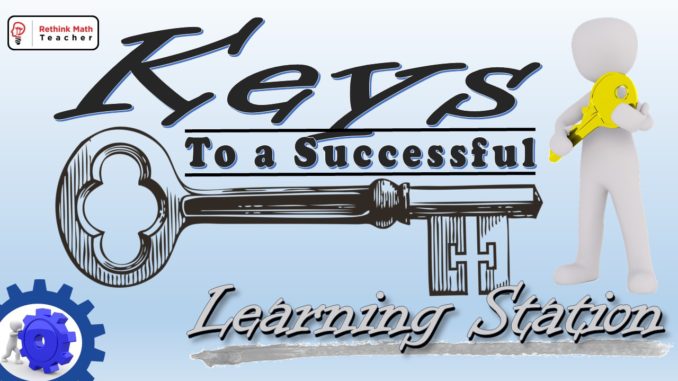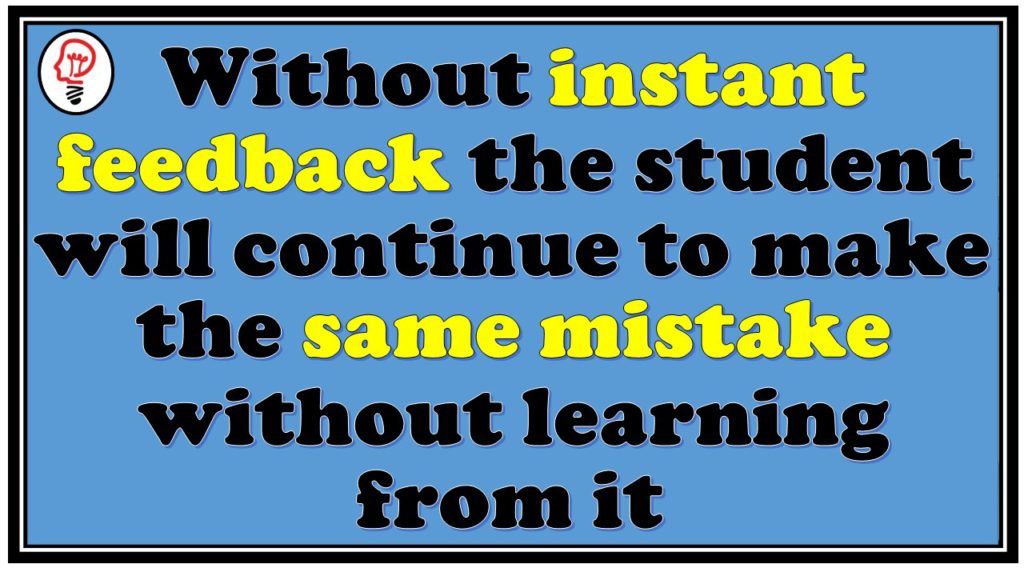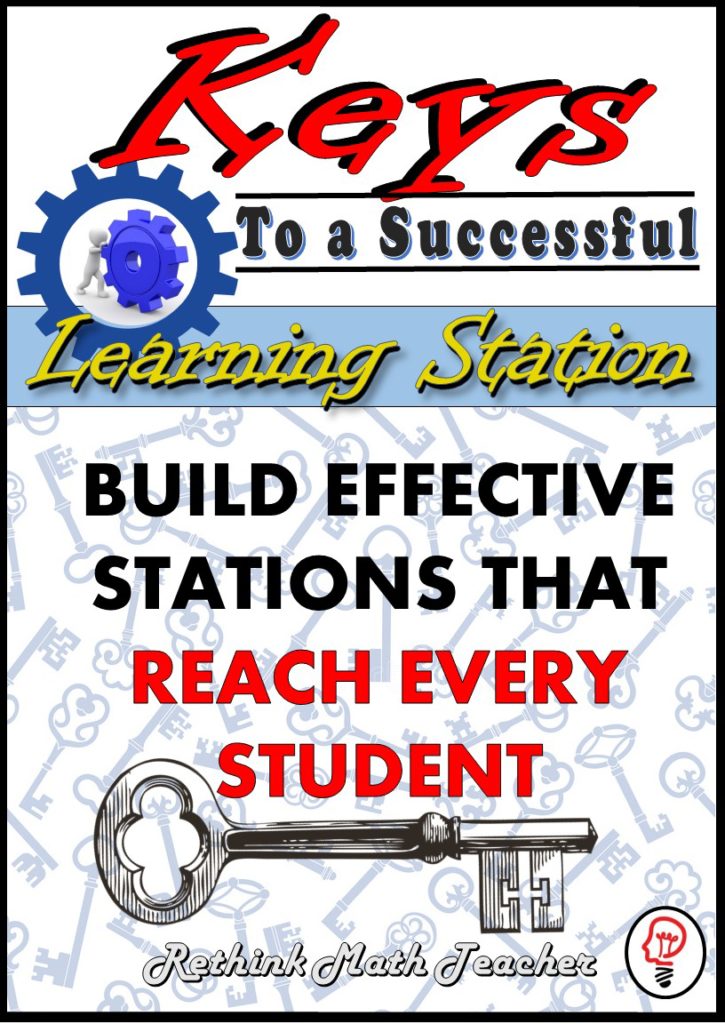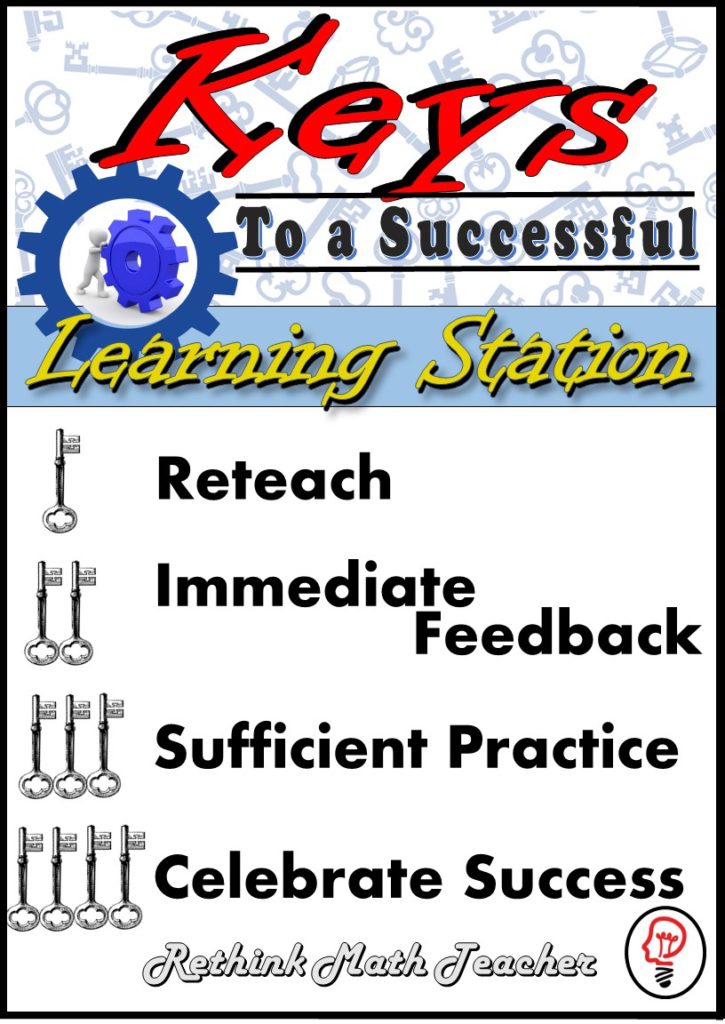
Learning Stations are becoming more and more popular. However, many schools and teachers are implementing them ineffectively. With a focus on a few key points, your learning stations will have a great impact on your students.
If I didn’t know it yesterday, why would I know it today?
I once returned a test to my students, and the entire class had done very poorly on it. I was very frustrated, because I knew we had covered the topic in great detail, and the students should have done much better on it.
Being the benevolent teacher that I was, I returned the test to them, with the grade on it, and I gave them the opportunity to redo the questions that they got wrong for partial credit.
One of the students, who had failed the test, looked at me and said, “If I didn’t know it yesterday, why would I know it today?”
Think about how you learn any new skill. First you are shown how to do it, then you practice it, your ability on that skill is critiqued based on your performance, corrections are made, and then you try again.
Yet, often in math education, we teach a skill, students don’t fully comprehend it, so we give them more practice on the same skill without ever giving them a reteach.
Practice without Reteach
I once observed a math teacher who started the class period by telling her students that they had done poorly on adding fractions. She then said, “so we’re going to work on it some more,” and proceeded to hand them a worksheet on adding fractions.
She was so frustrated when they all immediately raised their hand, asking for her help.
If the students hadn’t mastered it, they first needed a reteach before they could be expected to complete the worksheet properly.
The Essentials
When you build a learning station, the idea is for the student to be able to practice the skill without the need of the teacher walking them through every step. Thus, a reteach is essential. And it needs to be one that the students can do without the teacher’s aide.
If possible, the reteach should be on some technological devise, where students can watch a video and listen to the sound as they take notes. But, if you do not have access to such technology, you can use the textbook or reteach worksheets.
The first key to a successful learning station is a reteach
They made the same mistake on every problem
I once did a formal observation on a math teacher who was doing ‘learning stations’ on dividing with decimals. The first station had students in front of tablets, practicing the skill on IXL.com. At the second station, the teacher had created a small group and was practicing place values with some manipulatives. At the third station, students completed a worksheet on dividing decimals.
Note, this is not how we teach you to use learning stations. To learn more about the method we recommend, click here.
As I circulated the room, I made my way to the station where the students were working on the worksheet. Sadly, the students had done almost a dozen problems, but all of them were done incorrectly. The students in this station still did not understand how to move the decimal on these problems, and were repeating the same mistake on every question without knowing it.
Not only were the students practicing the skill incorrectly, they also were not learning from their mistakes.
This is not an efficient use of class time. The students are not learning the skill that they are supposed to, and a bad habit is being reinforced, which will make it harder for the students to learn the correct method later on.
The Mistake Teacher
Mistakes are a valuable teacher. They help us understand what not to do, and they force us to reevaluate our methods to determine why the one that we are using isn’t working – as well as how we can fix it.
However, without instant feedback, the student will continue making the same mistakes, never learning from them.
If you have access to technology, there are some great online programs that will give the student immediate feedback after each question. This is ideal for practice inside the learning station.
However, if you do not have this access, you can still provide worksheets or textbook work with answer sheets as the independent practice.
But you must teach your students to do the work, and then check their answers on the answer sheet. You must also teach them that if they make a mistake, to not simply change the answer, but that they must go back and rework the problem so that they can arrive at the correct solution.
The second key to successful learning stations is immediate feedback
If you found this article helpful, save it to your Pinterest Board
to reference later
We’re all slow learners at something
We all learn new skills at different paces.
For example, I am fairly decent at learning mechanical skills, such as electrical wiring. However, snowboarding and surfing was something that took me a long time, and many wipeouts, to grasp.
This doesn’t make me dumb, it makes me uncoordinated. And a slow learner in this department.
You have students who are slow learners when it comes to academics, and some of them are mathematically uncoordinated.
They require more practice then the average student to master the skill. So give it to them!
We teach educators to build a learning station that lasts three days, and has lots of practice in it. However, for some of your students, this will not be enough, and they will need to do the station several times before they finally grasp the concept.
I had one student who spent several weeks in the ‘adding integers’ learning station before she finally mastered it.
When you allow a student to work on a skill until they master it, you are conveying several important messages to them.
- The skill is important
- You are expected to master it
- I will not leave you behind
- I want you to be successful
And when they finally master it, after lots of repetition, they will be filled with pride and joy; and they will have gained confidence in their own abilities.
The student I mentioned earlier hated that she was stuck in one station for so long. But when she finally got it, she was so proud of herself. And with her new found confidence, she proceeded through the next several station with great speed.
The third key to a successful learning station is sufficient practice
We are the Champions
In my classroom, the learning stations were outlined on the wall with banners that celebrated students’ accomplishments. After the three day learning station, the students would take a short assessment to demonstrate mastery. Students who scored an 80% or better were promoted to the next station. Those who scored lower than an 80% repeated the station for another three day cycle.
That fourth day was called ‘Promotion Day.’ After I had graded the assessment, I read the names of everyone who had passed their test, thus mastering a new skill. As I read their names, everyone clapped, we played ‘We are the Champions’ by Queen, and students got to place their names under the banner showing their accomplishments.
You would think that these inner city middle school students at a Title 1 school would find this cheesy. But the truth is, they loved it! Every day they came in, asking me if it was promotion day.
Everyone likes to feel successful. So celebrate their success. Make it a big deal. Your students will work harder for you, and get more out of their education when you help them understand their success, and how wonderful it is.
The fourth key to a successful learning station is celebrating success
To learn more about how to create learning stations, click here.



